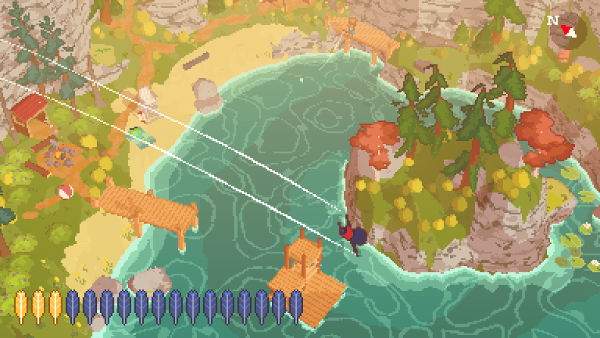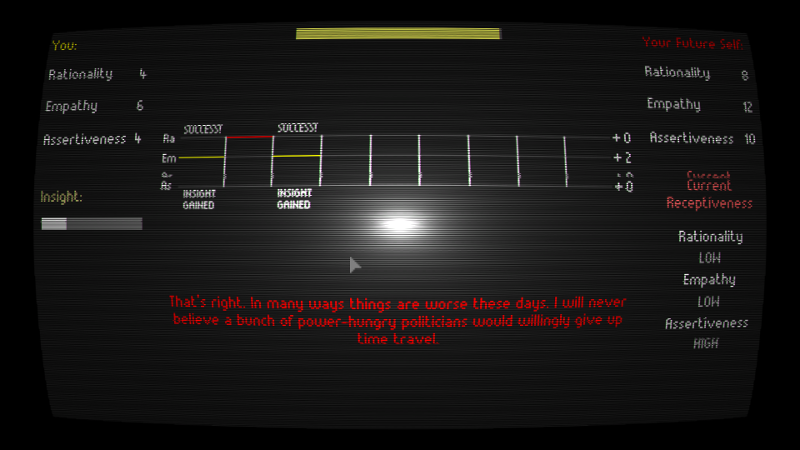Latest reviews
A depiciton of scenes with minimalist graphics and some objects in places/situations that are out of the ordinary. The only interaction happens at pauses where you are forced to click flashing objects to move to the next segment.
I made it through 3 uninspiring scenes before tapping out. I found the style interesting, but it didn’t go anywhere. The scenes aren’t pretty enough to be appreciated solely for beauty and I found no insight in the places forms were changed from the ordinary.
A Short Hike lets you explore the colorful, pixelated world of Hawk Peak Provincial Park in the role of a vacationing anthropomorphic bird named Claire. Your mission, should you choose to accept it, is to make it to the top of Hawk Peak, ostensibly in search of cell phone reception.
As you make your way through the park, you meet a diverse cast of animal characters. Some offer you side quests, others are simply pursuing their own adventures in the park. It’s up to you whether you want to accept any of these quests, but if you want to make it to the peak, you’ll need to at least obtain a few golden feathers, which allow you to climb the distance.
The game doesn’t end after you reach the peak. There are treasures to be found, hats to be purchased, fish to be caught, and co-operative games of beachstickball to be played. And it’s fun to explore. In spite of the intentionally low resolution graphics, when you sky-dive from the top of a hill, A Short Hike manages to convey a real sense of velocity and freedom.

You can fly, dive, swim, climb, walk, and run. (Credit: Adam Robinson-Yu. Fair use.)
You can’t die in this world, or screw up in any irreversible way. Nor does the game offer the endless grind of more complex farming, fishing, and crafting games. You can rush through the game, or spend a few hours with it, but after that, you’ll likely be done with it—at least until you feel like paying another visit to the park.
If you’re looking for a game to challenge your reflexes or your logic, this ain’t it. But if you just want to chill in a beautiful setting, it’s a perfect pick-me-up.
Sapiens: A Brief History of Humankind tries to present the entire Homo Sapiens existence in a single book, through the analysis of three fundamental revolutions that witnessed humankind as the protagonist: the Cognitive revolution, the Agricultural revolution and the Scientific revolution.
Keeping this simple chronological structure, the author provides challenging ideas and presents historical fact in a way that I haven’t personally seen before.
I found the book well written and thought provoking. Most of the time the author doesn’t provide a single view on a topic but presents different angles and interpretations explaining their pros and cons. This often led me to argue by myself for one or the other view and comparing my observations to the ones provided by the author.
Throughout the book you can hear loud and clear what is probably one of the obsessions of the author. Most of the topics presented are filtered through the question “Did this improve the happiness of humankind? What about the happiness of the individual?”. This, as far as I know, is a reading that is seldom presented in schools or by other historians and gives a whole different perspective on history. You will find yourself challenged by claims that might have never occurred to you and might make you uncomfortable. You will be asked to rethink or solidify your positions on sex and gender, twentieth century ideologies, religion, racism, slavery, equality, animal rights, morals and ethics, individualism, nationalism and consumerism.
The author saves the last couple of chapters for what they probably consider the most important questions to ask ourselves. Are you happy? Are you entitled to decide of your own happiness? What is happiness? Is it equivalent to pleasure? Can we reverse engineer happiness? And again, can we hack evolution and take control of it, decide where to go next? Can we achieve supernatural abilities, enhance ourselves or are we doomed to go the way of Dr. Frankenstein? What are the ethical implications of all this? Can we even imagine a future in which Homo Sapiens is not a “God on earth”, in which it’s not the dominant species?
At times the author makes little effort to hide their personal beliefs. From reading the book I would assume the author is vegan (or at least supports the animal rights movement) and a Buddhist (especially interested in the peculiar Buddhist idea of happiness). This is not necessarily a negative but occasionally alters the impartiality of the author in analyzing a topic.
The last chapter also provides a series of “predictions” about the future of humans and technology. While this is done to lead the reader to more philosophical questions, these are still predictions of a 2014 (non necessarily tech-savvy) person. This felt like reading a novel from the Fifties talking about the technology of the future. A few of them have a sci-fi taste and in other cases are simply outdated (especially when it comes to AI and superintelligence). This is not necessarily the author’s fault and actually confirms the fact that scientific research is advancing faster than the average Homo Sapiens can manage to process.
I would suggest it to anyone who is looking for a non-fiction book than can help you rethink yourself as a person and ourselves as a species.
In Some Assembly Required, biologist Neil Shubin explores a theme he already touched upon in his 2008 book Your Inner Fish and the 2014 PBS documentary of the same name: How do complex bodies, with all their specialized functions, evolve? How does evolution build on that which has come before?
To answer these questions, Shubin revisits the discoveries of biologists and naturalists of the past and introduces some of the most recent findings of molecular biology. This is a popular science book, so scientific facts become stories whose protagonists are brought to life with biographical detail.
The key concepts Shubin introduces include:
-
how biological traits that have evolved for one function are re-purposed (exapted) for another (e.g., feathers likely evolved first for temperature regulation, then were exapted for flight);
-
how small changes in embryonic development can have dramatic effects on the resulting individual—e.g., the slowing of physiological development known as neoteny, where adults may retain traits otherwise only seen in the young;
-
how gene duplication events (e.g., via self-copying genes known as transposons or “jumping genes”) enable evolution to experiment with myriad small variations of existing genetic recipes, which has led to vast gene and protein families;
-
how plant and animal cells incorporated previously free-living organisms and thereby gained crucial new capabilities, the classic examples being mitochondria (the powerhouses of animal cells) and chloroplasts (the photosynthesis engines of plant cells);
-
how viral elements have made their way into our DNA and have been co-opted for important biological functions (e.g., to make the protein syncytin, which is a key component of the placental barrier between fetus and mother).
Shubin explains how evolution often arrives at the same solution multiple times, with different genetic origins, and illuminates why some evolutionary pathways are likelier than others.

A retrovirus upon integration in the host genome (A), where its genetic code has been co-opted for building a protein used in placental development (B, top), and for the regulation of birth timing (B, bottom). (Credit: PLOS Biology / Edward B. Chuong. License: CC-BY.)
The book only scratches the surface of these concepts, and much of what it does cover is likely to be well-trodden ground for readers who have picked up a book about evolutionary biology since their school days. At the end of each chapter, I found myself hungry for more detail.
To Shubin’s credit, in the final section of the book, he provides a kind of afterword for each chapter, which includes sources and additional reading recommendations. I found this approach much more useful than a conventional bibliography or a set of disjointed footnotes.
I would give this book 4 stars — it’s a light, quick and engaging read on a fascinating topic. For readers looking for more breadth or more depth, I would recommend the following writers:
-
Richard Dawkins, if you are not put off by his politics, is still one of the best science writers I know. The Greatest Show on Earth: The Evidence for Evolution (2009; reviews) is a passionate, detailed and eloquent introduction to evolutionary biology.
-
Nessa Carey has a remarkable talent for getting as close to the science as possible while still writing for a lay audience. I read The Epigenetics Revolution (2012) and was deeply impressed by her clarity and ability to break down very complex concepts.
-
Andreas Wagner is a biologist bringing his own ideas to a larger audience through popular science writing. If the science behind it withstands scrutiny, Arrival of the Fittest (2014; reviews) could well be turned into a new chapter in the next edition of Some Assembly Required.
In short, Wagner argues that in order to find new functions for old genes, evolution has to take a “genetic walk” from A (old function) to B (new function). He explains the importance of neutral mutations in these genetic walks. His latest book, Life Finds a Way: What Evolution Teaches Us About Creativity, looks similarly fascinating.
If you’re on the fence about Some Assembly Required, consider getting a copy of the PBS documentary Your Inner Fish. It showcases Shubin’s storytelling talent while still packing a good amount of science. If you enjoy it, you’re unlikely to be disappointed by Some Assembly Required.
A Normal Lost Phone (reviews) by Accidental Queens allowed the player to explore a simulated smartphone to discover what happened to its owner, an 18-year-old named Sam. Another Lost Phone uses the same idea to explore different themes. This time, the phone in question belongs to a woman named Laura, who has apparently gone missing.
SMS messages reveal that her boyfriend, Ben, is deeply concerned about her disappearance—but some of his earlier messages suggest a controlling personality, hinting at another story to be uncovered.
The story is told through messages, photos, emails, calendar entries, and notes, many of which are only accessible until you’ve figured out a password or PIN number through various clues. Most of these puzzles are pretty easy, but if you find yourself getting stuck, the excellent Steam Guide will help you to advance without any spoilers.

The first messages we see are from Laura’s boyfriend Ben, expressing deep concern about her disappearance. (Credit: Accidental Queens. Fair use.)
Like the first game, Another Lost Phone explores sensitive social topics with appropriate care, if you can get past the inherently voyeuristic storytelling device of exploring a stranger’s phone.
The game feels a bit more polished than A Normal Lost Phone, with a more engaging story, where all the different pieces (messages and clues) click together really well. Each game tells its own independent story, and if you’re unsure which one to try first, I recommend this one. My playtime was about 1-2 hours.
“The Road To Forgiveness” - By: Bill and Cindy Griffiths is a powerful true story of a couple who forgave the woman who hit and killed their daughter and mother / mother-in-law while driving drunk. It’s one of the best books I have ever read. If you are interested in powerful, true stories you should love this book.
What’s not to love? I can’t go wrong with classic hymns and my favorite singer. I absolutely love it! There are a lot of great voices in music, but none of them touch my heart more than Lauren’s voice does. I only wish there were more songs. Lauren explained that she didn’t want to put too many songs on this release because she didn’t want the majority of them to be overlooked. She wanted more attention to be paid to each individual song that’s on the release. I can understand this reasoning but I still wish there were more songs. Only 6 songs here, but a great EP by Lauren Talley.
Gladiabots is a strategy game where you program a team of robots to win battles. There is 3 different game modes, elimination, domination and collection. The single player is lengthy with many levels of increasing difficulty with the layout of the arena and enemy team varying enough to keep it interesting.
The gameplay is half programming, half watching your team do battle. The programming is easy to get started with as every thing is done visually. You layout commands with the leftmost having the most priority. As you try to make your robots behavior more specific, the visual programming becomes a hinderence and anybody whos written code will be yearning to play the game by actually programming. Watching the battles stays fairly entertaining since you can speed up or slow down to only watch the parts that show if your programming is working.
There’s definitely bugs where the game doesn’t execute the programming properly, but they’re rare enough not to impact gameplay. The game also wants you to sign into an account to share your score and will ask you to sign in after EVERY game if you don’t. The game also comes with data collection for the Unreal engine turned on. On Linux, you can see the settings in .config/unity3d/GFX47/Gladiabots/prefs. There was no notice about this either. I only happened to find it while trying to debug a bad build of the game.
<pref name="data.analyticsEnabled" type="int">1</pref>
<pref name="data.deviceStatsEnabled" type="int">1</pref>
<pref name="data.limitUserTracking" type="int">0</pref>
<pref name="data.optOut" type="int">0</pref>
<pref name="data.performanceReportingEnabled" type="int">1</pref>
<pref name="unity.cloud_userid" type="string">ZGVlOTlkNDBhYzc0NzQzNGE5NThiN2JhOThiMGYyZDk=</pref>
<pref name="unity.player_session_count" type="string">MTE=</pref>
<pref name="unity.player_sessionid" type="string">MTYxNTUyNjIwOTAyNzUzOTA3OQ==</pref>
Unplayed: Multiplayer, Collection Mode
Overall, its worth a play.
I lived in the San Francisco Bay Area from 2008 to 2015. One name that you’ll encounter sooner or later in this region of the United States is Junípero Serra: from Junipero Serra Freeway to Junipero Serra Boulevard, from schools to playgrounds, from hiking trails to the highest mountain peak in Monterey County, and of course the statues—so many statues.
Canonized as a saint in 2015, Serra was an 18th century priest and friar who founded the first Spanish missions in California. Pope Francis claimed that Serra “sought to defend the dignity of the native community, to protect it from those who had mistreated and abused it.” The missions Serra started are popular tourist attractions.
In 2004, Elias Castillo (1939-2020), a journalist and three-time Pulitzer Prize nominee, wrote an op-ed titled “The dark, terrible secret of California’s missions” that described Serra’s work in starkly different terms:
[L]ocked within the missions is a terrible truth—that they were little more than concentration camps where California’s Indians were beaten, whipped, maimed, burned, tortured and virtually exterminated by the friars.
The op-ed was well-received by others familiar with this history, and was read into the Congressional Record. This inspired Castillo to write the book A Cross of Thorns: The Enslavement of California’s Indians by the Spanish Missions (2015).
Castillo documents that Serra was a reactionary even by 18th century standards, a man who believed in witches, rejected Copernicus, practiced extreme self-flagellation, and regarded the natives of California as savages who had to be enslaved to be brought to salvation.

Yokuts hunting near San Francisco Bay as depicted by Russian artist Ludwig Chloris. (Public domain)
Fever dreams of salvation
Natives were herded into the missions and were forcibly returned there if they tried to flee. They lived in conditions of forced labour, and died by the thousands, often from disease which ran rampant due to the high population density. Far from “protecting” the natives, Serra resisted efforts to reduce the rate of death, to provide education or better care.
Instead of education, there was daily mass in Latin, which the natives did not understand. The Church enforced its sexual morality, separated men from women, and punished expressions of intense emotion, including grief. In a 1780 letter to Felipe de Neve, then governor of the Californias, Serra justified the use of flogging:
“That spiritual fathers should punish their sons, the Indians, with blows appears to be as old as the conquest of these kingdoms [the Americas]; so general in fact that the saints do not seem to be any exception to the rule. In the life of Saint Francis Solano … we read that, while he had a special gift from God to soften the ferocity of the most barbarous by the sweetness of his presence and words, nevertheless … when they failed to carry out his orders, he gave directions for his Indians to be whipped.”
Castillo’s book is unsparing but rigorous and well-sourced, often in the words of the people who committed these crimes or witnessed them. The many dedications to Serra in California are honoring a mass murderer. His canonization will forever taint the record of Pope Francis, who is often celebrated as a reformer.
In the wake of calls for racial justice in 2020, this history is becoming more widely known, and the first Serra statues are being removed. The myth of the friendly California missions has no place in the 21st century, and Castillo’s book should help us all to put it to rest.
Additional reading
-
Junípero Serra’s brutal story in spotlight as pope prepares for canonisation
The Guardian, September 23, 2015 -
Junipero Serra was a brutal colonialist. So why did Pope Francis just make him a saint?
Vox, September 24, 2015 -
‘By Their Fruit They Will Be Known’: Junipero Serra as Indian Killer
Indian Country Today, October 14, 2015 -
Sainthood of Junípero Serra Reopens Wounds of Colonialism in California
New York Times, September 29, 2015
Your Future Self is an interactive story developed by Contortionist Games, which as of this writing is one developer, Andrew Hirst, based in Sheffield, UK. The game presents itself in a CRT aesthetic with many flicker effects, similar to Pony Island.
The premise is that you’re stuck in a time looping bubble with your future self and have to convince them not to commit an act that will kill thousands of people, but which your future self clearly considered justifiable. Every dialog choice can succeed or fail. If you ultimately don’t succeed, the loop starts again.
As you pick from different strategies to engage with “yourself”, the story unfolds. You can’t pick the exact words you want to say to yourself—your choices are always to be rational, empathetic, or assertive, and the game decides what that means in a given context.
There’s a light RPG-like mechanic at play here, where your “skill” at being rational, empathetic, or assertive is measured against your future self’s skills and receptivity in those areas. If you turned on “helper mode” on the start screen, the game shows you the likelihood that a given choice will succeed.

The success or failure of your attempts to persuade your future self is visualized, and is subject to a simple RPG-like mechanic. The CRT scanline effect, curved screen, and center glare are in-game visuals. (Credit: Contortionist Games. Fair use.)
There are, of course, additional layers to the story, and the game employs intense visual effects to keep things interesting. It also has an excellent chiptune soundtrack. Check out Rebels to the Rescue and Your Future Self (Remix).
The time loop mechanic can get a bit tedious if you have to click through the same loop a couple of times to find the right answers—in retrospect I think I would have enjoyed the game more if I had enabled “Helper mode”. The story was interesting enough to keep me engaged until the ending (I think I played for about 1-2 hours).
I’d give it 4 stars—the game mechanics and story aren’t perfect, but the excellent soundtrack and atmosphere make up for most of the game’s weaknesses.
